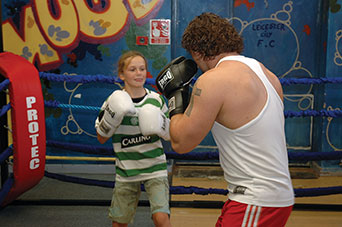Changing understandings of work with young people
Within the UK, the 1990s and 2000s have seen considerable changes in work with young people. These changes have had varying emphasis within the different nations of the UK but many of the prevailing themes remain constant. Jason Wood and Jean Hine have related the development of changing practices to changing ideas about young people (Wood and Hine, 2013). Wood and Hine argue that under the Labour government between 1997 and 2010, government policy defining services for young people reflected two dominant understandings of young people.
- The first is that young people are prone to ‘risky’ behaviour. The idea of ‘risky’ behaviour encompasses, for example, youth crime, use and misuse of drugs and alcohol, or young parenthood. Wood and Hine suggest that ‘this concern with risky behaviour drives a desire to predict it and stop it’ and thus much practice with young people is aimed at prevention and targeted at groups that are deemed most likely to be ‘at risk’.
This label of ‘at risk’ is often used as a way of describing a generic group of young people (such as those who have few qualifications). It is not one that is necessarily used by young people to describe themselves and may not take into account the individual situations of particular young people (Smith et al., 2007). For example, within this perspective a young mother and her child are both seen to be ‘at risk’ of poor outcomes and the dominant view is that young motherhood is something to be ‘prevented’. However, any individual young woman may, in reality, be happy to start a family and may describe herself as a parent within the context of a loving relationship (Arai, 2010).
- The second dominant understanding of young people that Wood and Hine describe is that of ‘Dealing with young people for what they might become’. This view of young people sees them as needing to be prepared for adulthood, with this taking precedence over their lives here and now. It tends to see the activity of young people as being a kind of rehearsal for the real thing. For example, romantic relationships of young people may not be seen as important or as ‘genuine’ as those of older people.
This approach suggests an emphasis on the importance of training and education for young people, and can also be associated with encouraging broader preconceived notions of adulthood. These notions often assume that young people need to develop a ‘mature’ way of behaving (such as not drinking to excess) – whether or not this reflects the reality of the lives of many adults. We would argue that work with young people can see them as both ‘being’ and ‘becoming’ – with what they feel and do today being just as important as what they might do later in their life.
Mark Smith develops these themes in a discussion of work with young people throughout Great Britain. He argues that much work with young people in England has been influenced by ‘social work framework[s]’ (Smith, 2007) and has become more concerned with individuals and a focus on outcomes or pre-defined results. Much of the recent policy documentation in Scotland reflects similar concerns, concentrating on ‘specialised targeted provision designed to meet the needs of young people who are particularly vulnerable or who have specific needs’ (Scottish Executive, 2007, p. 4). Looking at Welsh policy documents, Smith acknowledges that this trend is less evident, but suggests that once again there is a strong emphasis upon the meeting of numerous targets. He would welcome more emphasis on the traditional encouragement within Wales of activities that are initiated by and within communities (Smith, 2007).
Taken together this evidence suggests that there is a general move in activity with young people, throughout Great Britain, toward the targeted end of our spectrum, with more emphasis on targeted programmes such as youth training or youth justice.
This has two possible consequences.
- First, a predominant view of young people as vulnerable or disadvantaged can be stigmatising and suggest that they are ‘lacking’ rather than having strengths that can be built upon.
- Secondly, universal and open-access provision – such as clubs and youth groups exemplified on the left of our spectrum – tends to be seen by policymakers as of reduced importance. Consequently, there is a loss of the types of settings for young people that are more concerned with the importance of ‘being’ – having fun, doing things, developing relationships and so on.
The shift is most clearly seen within provision provided by the local authority and funded by the state (statutory provision), but can also occur within some voluntary-sector organisations where they rely on funding that supports the shift in emphasis. However, perhaps fortunately, some other voluntary organisations such as the Scouts and Guides that use voluntary workers and raise most of their own funds will be affected only marginally by such changes in policy.

At the time of writing (late 2012) there appears to be a popular and political interest in ‘positive’ activities in the UK – the London 2012 Olympics has increased interest in sport, for example – and the role of the voluntary sector is particularly emphasised. This suggests an increase in open-access provision on the left of the spectrum. However, funding is limited due to government cuts so there is likely to be less provision overall. Many services at the right-hand end of the spectrum are hard to cut because of legal requirements such as safeguarding. Consequently, it may be that cuts are implemented in the centre of the spectrum where provision has an element of targeting but is not ‘essential’, resulting in a shift of focus away from the centre towards both the left and right in the months and years to come.
A shift from state-funded to voluntary provision is in line with the idea of the ‘Big Society’ introduced by the coalition government that came to power in the UK in 2010, and associated personally with the prime minister, David Cameron. The Big Society is described on a government website as being about:
shifting the culture – from government action to local action. This is not about encouraging volunteering for the sake of it. This is about equipping people and organisations with the power and resources they need to make a real difference in their communities.
Throughout our communities there is a great appetite for involvement in local initiatives and people do want to make a difference in their area.
Mr Cameron insists that the idea is not, as some critics claim, ‘a cover for cuts’. He argues that it is of value in itself, though of particular benefit at a time when cuts in spending are being made.
It is not a cover for anything. It is a good thing to try and build a bigger and stronger society, whatever is happening to public spending. But I would make this argument: whoever was standing here right now as Prime Minister would be having to make cuts in public spending, and isn’t it better if we are having to make cuts in public spending, to try and encourage a bigger and stronger society at the same time? If there are facilities that the state can’t afford to keep open, shouldn’t we be trying to encourage communities who want to come forward and help them and run them?
The final activity in this course invites you to introduce a setting that you are familiar with and to consider how you might locate it within this discussion.
Activity 6: Analysing practice settings
This activity encourages you to think more deeply about your own practice setting, or one with which you are familiar. It is an opportunity to analyse your chosen practice setting. In order to help you with this we will bring together the principal descriptive and reflective ideas that we have discussed throughout the course.
First, let us recall the main descriptive features that we identified in Section 1 as characterising work with young people:
- the location of the work
- the organisation that is responsible for the work
- the type of work that takes place there and its aim
- whether provision is part time or full time
- the role of the person/people doing the work
- employment arrangements – whether work is paid or unpaid, for example
- whether the setting receives funding and/or charges fees
- whether the setting needs to report to anyone else about what it does.
Then we can move on to ideas that help us to reflect on the work. In Section 2 of this course, we introduced four ideas that appear to be common to work with young people across a range of settings:
- informal education – personal development and learning from the everyday
- social contact with other young people and the wider society
- recreation and enjoyment
- development of voice and influence.
Alongside these common features, however, there are differences, which are captured in two models that we presented:
- the three circles of youth leisure, youth work and youth social work and training (see Figure 4)
- the spectrum from open access to targeted provision.
This activity is a revision exercise for the course, but one in which you are involved actively and creatively, by applying the ideas to practice. We hope that it will help you to develop your thinking a little further, and perhaps raise questions and issues that you can share with colleagues in your tutor group or on the tutor-group forum.
Think about a setting for work with young people that you are familiar with. We have provided a list of questions to help you to describe and analyse this setting in relation to ideas that we have discussed within this course.
Work through the questions below, noting your answers to the different descriptive and analytical questions in the answer box provided. The aim of this activity is to help you think through the nature and purpose of the setting with regard to its work with young people. If it is a setting that you work in, you may find it helpful to sit down with a colleague or friend and look at the questions together. If you are unable to answer any of the questions just go on to the next – but if you have the chance, see if you can find out the answer at a later date.
| Description |
| Where is the work located? |
| What is the organisation that is responsible for the work? Can you name the sector that it is in? (It might be the voluntary, statutory or private sector. If you are unsure then ask someone in the setting.) |
| How would you describe the work that takes place there? |
| What is the aim of the work? |
| Is the provision part time (say, one evening a week) or full time? |
| Can you describe the role(s) of the person/people doing the work? |
| Are the workers paid or unpaid? |
How does the setting pay for the activity that takes place? Does it receive funding from elsewhere? If so where? Does it charge fees? Do members raise money for activity? |
| Does anyone in the setting need to report its activity to anyone outside the setting? If so, how does this take place? |
| Reflection |
| How does the setting encourage informal education (personal development and learning from the everyday)? Can you give an example? |
| How does the setting encourage social contact with other young people and the wider society? |
| Does the setting encourage recreation and enjoyment? If so, how? |
| Does the setting encourage development of voice and influence? If so, how? |
Does the setting fall principally into one of the circles associated with youth leisure work, youth work or youth social work? Is it in one of the overlapping spaces? If so, which? Or does it encompass activity from all three of the circles? Try to explain why you come to your conclusions. |
| Where would you put the setting on a continuum from open access (on the left) to targeted (on the right)? Why? |

Discussion
This activity aims to help you to both describe and analyse a setting of your choice. In this course we have introduced you to a variety of perspectives and models of analysis, and this activity gives you an opportunity to apply these. We hope that, by working through the questions and reading the comments of your tutor group, you have learned something new or now understand an old idea in a slightly different – perhaps surprising – way. We hope, also, that you will find yourself starting to develop a new ‘language’ to support the discussion of settings for work with young people – one that is shared with others who are involved in or interested in this field of practice. Once you are comfortable with this new language it is likely to help you in both your study and the time you spend with young people.
